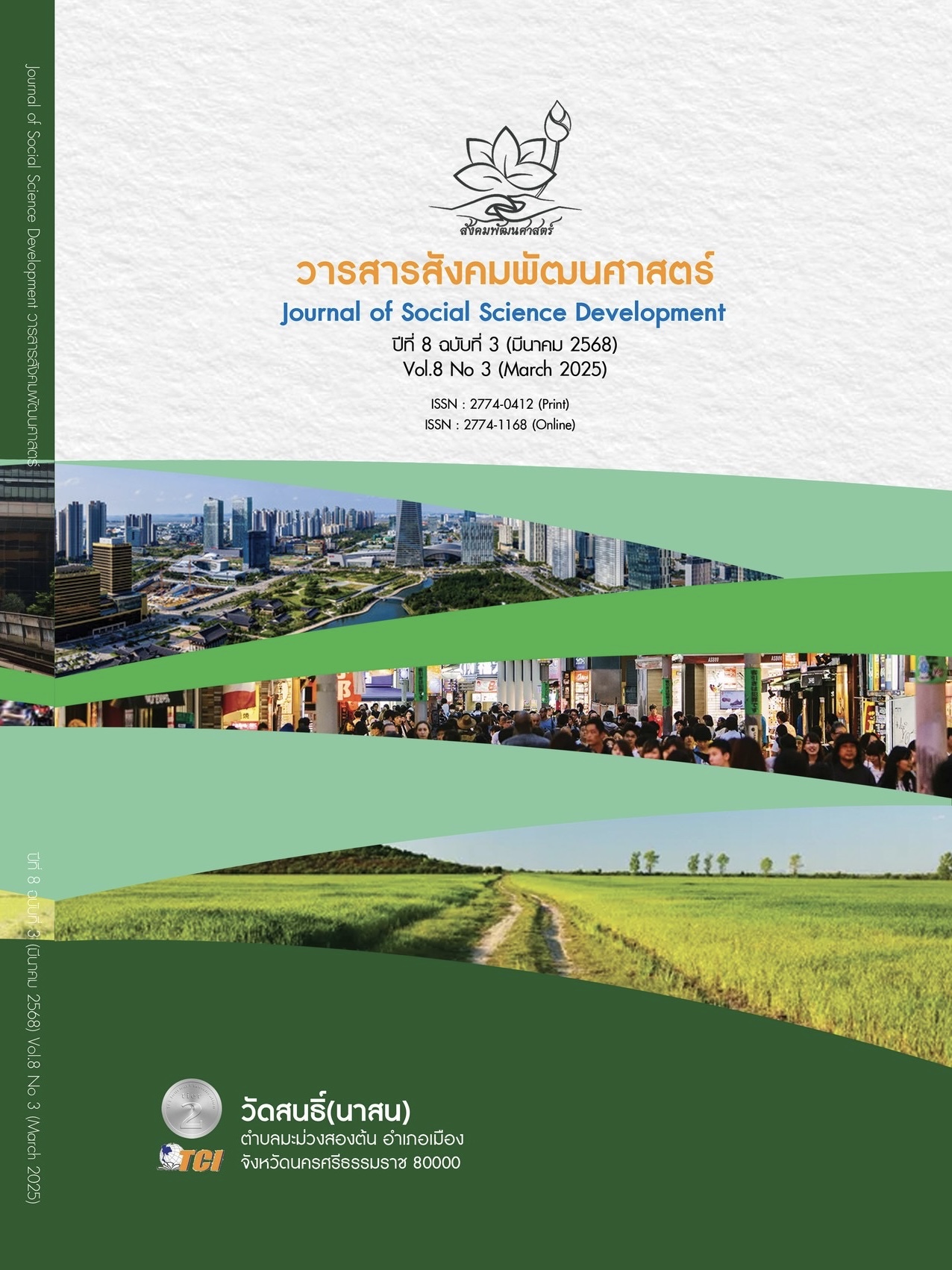การพัฒนาศูนย์การเรียนรู้หลักสูตรการแปรรูปกะปิ (เคย) เพื่อสร้างความมั่นคงทางด้านอาหารในชุมชนบริเวณหาดทุ่งใส
Main Article Content
บทคัดย่อ
บทความนี้เป็นการนำเสนอเรื่องการพัฒนาศูนย์การเรียนรู้หลักสูตรการแปรรูปกะปิ (เคย) เพื่อสร้างความมั่นคงทางด้านอาหารในชุมชนบริเวณหาดทุ่งใส หรือที่เรียกว่า “อ่าวทุ่งใส” เป็นชายหาดที่ทอดยาวจากเชิงเขาพลายดำจรดปากน้ำสิชล ลักษณะสภาพภูมิศาสตร์ที่เป็นชายฝั่งทะเลทำให้พื้นที่มีความหลากหลายและความสมบูรณ์ของทรัพยากร พลวัตการเปลี่ยนแปลงในวิถีบริโภคถูกบ่มเพาะกลายเป็นภูมิปัญญาและวัฒนธรรมอาหาร เมื่อความสมบูรณ์ของทรัพยากรลดลงจากการขยายพื้นที่ในการบริโภคมากขึ้น ทำให้ชุมชนเกิดความตระหนักถึงเสถียรภาพความมั่นคงด้านอาหาร ชุมชนจึงมีการจัดการตนเองในการอนุรักษ์ทรัพยากรและแก้ไขปัญหาโดยมีส่วนร่วมในการทำงานร่วมกันอย่างมีเป้าหมาย และใช้ทรัพยากรอย่างยั่งยืน จนเกิดเป็นศูนย์การเรียนรู้ชุมชนหาดทุ่งใสเป้าหมายเพื่อพัฒนาคุณภาพชีวิตและสร้างความเข้มแข็งเครือข่ายประมง เมื่อสังคมและเศรษฐกิจเปลี่ยนแปลงต้องมีการปรับตัวเพื่อเรียนรู้การดำรงชีพ การสร้างคุณค่าอาหาร และวัฒนธรรมการกิน ซึ่งเป็นสิ่งสำคัญที่บ่งชี้ถึงวิถีชีวิตและการเปลี่ยนแปลงสังคมวัฒนธรรมด้วยเช่นกัน ดังเช่น อาหารพื้นบ้านดั้งเดิมที่มีการสืบทอดเป็นอัตลักษณ์ชุมชน นั้นคือ กะปิกุ้งเคย จากการเห็นคุณค่าภูมิปัญญาและเสถียรภาพความมั่นคงด้านอาหารศูนย์การเรียนรู้จึงได้พัฒนาภูมิความรู้จากวิถีการบริโภคอาหาร และภูมิปัญญาอันเป็นรากฐานแห่งวัฒนธรรมและสังคมโดยผ่านกระบวนการปฏิบัติการตามรูปแบบการเรียนรู้อย่างเท่าเทียมตลอดชีวิต เน้นการจัดเก็บองค์ความรู้เพื่อดำรงชีพและได้ถูกพัฒนาเป็นสูตรอาหารที่มีมาตรฐาน เช่น เคยเจี้ยน เคยคั่ว และเคยหวาน (“เคย”เป็นภาษาถิ่น หมายถึง “กะปิ”) เพื่อสร้างความมั่นคงทางด้านอาหารอย่างยั่งยืนในชุมชน
Article Details

This work is licensed under a Creative Commons Attribution-NonCommercial-NoDerivatives 4.0 International License.
References
กีรติพร จูตะวิริยะ และคณะ. (2554). วิถีการบริโภคอาหารกับการเปลี่ยนแปลงทางสังคมในยุคโลกาภิวัตน์ เขตนครหลวงเวียงจันทน์ สปป.ลาว. วารสารสังคมลุ่มน้ำโขง, 7(2), 49-73.
โกวิทย์ พวงงาม. (2562). การจัดการตนเองของชุมชนและท้องถิ่น. (พิมพ์ครั้งที่ 2). นนทบุรี: ธรรมสาร.
คณะกรรมการอาหารแห่งชาติ. (2560). กรอบยุทธศาสตร์การจัดการด้านอาหารของประเทศไทย ฉบับที่สอง พ.ศ. 2560 - 2579. กรุงเทพมหานคร: สำนักงานคณะกรรมการอาหารแห่งชาติ.
โครงการอนุรักษ์พันธุกรรมพืชอันเนื่องมาจากพระราชดำริ สมเด็จพระเทพรัตนราชสุดาฯ สยามบรมราชกุมารี. (2559). แผนแม่บทโครงการอนุรักษ์พันธุกรรมพืชอันเนื่องมาจากพระราชดำริสมเด็จพระเทพ รัตนราชสุดาฯ สยามบรมราชกุมารี. กรุงเทพมหานคร: โครงการอนุรักษ์พันธุกรรมพืชอันเนื่องมาจากพระราชดำริ สมเด็จพระเทพรัตนราชสุดาฯ สยามบรมราชกุมารี.
ฉัตรชัย แซ่อุย. (29 กรกฎาคม 2566). การพัฒนาศูนย์การเรียนรู้หลักสูตรการแปรรูปกะปิ (เคย) เพื่อสร้างความมั่นคงทางด้านอาหารในชุมชนบริเวณหาดทุ่งใส. (จิตติมา ดำรงวัฒนะ, ผู้สัมภาษณ์)
ทวีวัตร เครือสาย และคณะ. (2562). สานพลังก้าวข้ามขีดจํากัดสู่ความมั่นคงทางอาหาร. สงขลา: สถาบันการจัดการระบบสุขภาพ มหาวิทยาลัยสงขลานครินทร์.
นพรัตน์ ไชยชนะ และจักษุมาลย์ วงษ์ท้าว. (2561). ความมั่นคงทางอาหารในมิติวัฒนธรรมของกลุ่มชาติพันธุ์กะเหรี่ยงโปร์บ้านทิพุเย ตำบลชะแล อำเภอทองผาภูมิ จังหวัดกาญจนบุรี. วารสารสังคมศาสตร์ มหาวิทยาลัยวลัยลักษณ์, 11(1), 43-71.
ประสงค์ ตันพิชัย และคณะ. (2564). รายงานวิจัยฉบับสมบูรณ์ โครงการการพัฒนาเศรษฐกิจฐานรากภายใต้ความร่วมมือของภาคีภาครัฐ ภาคเอกชน และภาคประชาสังคมในการขับเคลื่อนการพัฒนาโซ่ แห่งคุณค่าของอาหารปลอดภัยในจังหวัดกาญจนบุรี. กรุงเทพมหานคร: สำนักงานคณะกรรมการส่งเสริมวิทยาศาสตร์ วิจัยและนวัตกรรม.
ประหยัด สายวิเชียร. (2547). อาหารและวัฒนธรรมและสุขภาพ. เชียงใหม่: นพบุรีการพิมพ จํากัด.
ปราณี ไชยรัตน์. (29 ก.ค. 2566). การพัฒนาศูนย์การเรียนรู้หลักสูตรการแปรรูปกะปิ (เคย) เพื่อสร้างความมั่นคงทางด้านอาหารในชุมชนบริเวณหาดทุ่งใส. (จิตติมา ดำรงวัฒนะ, ผู้สัมภาษณ์)
พรทิพย์ ติลกานันท์. (2557). การนำเสนอรูปแบบการเรียนรู้ของชุมชนเพื่อสร้างเสริมความมั่นคงทางอาหาร. ใน วิทยานิพนธ์ครุศาสตรดุษฏีบัณฑิต สาขาวิชาการศึกษาตลอดชีวิต. จุฬาลงกรณ์มหาวิทยาลัย.
รพีพร ธงทอง. (2565). สิทธิของประชาชนกับการบริหารงานภาครัฐตามหลักธรรมภิบาลที่มีผล ต่อคุณภาพชีวิตภายใต้สถานการณ์โควิท - 19 ในจังหวัดอุบลราชธานี. มจร อุบลปริทรรศน์, 7(2), 631-648.
วงศ์ตระกูล มาเกตุ. (2559). การสร้างการประกันความมั่นคงทางอาหารในระดับชุมชน: กรณีศึกษาชุมชนป่าตรง อําเภอเมืองปราจีนบุรี จังหวัดปราจีนบุรี. วารสารวิจัยและพัฒนา มหาวิทยาลัยราชภัฏเลย, 11(28), 67-76.
ศุภชัย กันเร็ว. (2568). บทบาทของอาหารไทยในบริบทสังคมวัฒนธรรมไทย. เรียกใช้เมื่อ 1 กุมภาพันธ์ 2568 จาก https://contributor.lib.kmutt.ac.th/@supachai/บทบาทของอาหารไทยในบริบทสังคมวัฒนธรรมไทย-9bfdfa2f-b629-45e5-ab35-4f0f19e63598
สำนักงานพัฒนาการวิจัยการเกษตร (องค์การมหาชน). (2568). ความมั่นคงทางอาหาร สิ่งที่ทุกคนควรได้รับอย่างเพียงพอ. เรียกใช้เมื่อ 1 กุมภาพันธ์ 2568 จาก https://www.arda.or.th/detail/6157
สุชาติ มันเหมาะ. (29 ก.ค. 2566). การพัฒนาศูนย์การเรียนรู้หลักสูตรการแปรรูปกะปิ (เคย) เพื่อสร้างความมั่นคงทางด้านอาหารในชุมชนบริเวณหาดทุ่งใส. (จิตติมา ดำรงวัฒนะ, ผู้สัมภาษณ์)
สุพจน์ หลี่จา. (2568). ชีวิตนอกกรุง: ปลูกความมั่นคงของชาวลีซูปางสา. เรียกใช้เมื่อ 1 กุมภาพันธ์ 2568 จาก https://thecitizen.plus/node/40272
สุพรรณี ไชยอําพร. (2560). ความมั่นคงทางอาหาร: สิ่งบ่งชี้ต่างวัฒนธรรมในสังคมไทย. วารสารพัฒนบริหารศาสตร์, 57(1), 200-223.
อัมรินทร์ นาคณัฐเศรษฐ์. (2558). การบริหารองค์ความรู้ในมหาวิทยาลัยสุโขทัยธรรมาธิราช ด้านการแลกเปลี่ยนและการบริการความรู้. วารสารชุมชนวิจัย มหาวิทยาลัยราชภัฏนครราชสีมา, 9(1), 40-50.
Cohen, D. & Prusak, L. (2001). In good company:How social capital makes organizations work. Boston, Mass: Harvard Business School Press.
Cronbach, L. J. (1990). Essentials of psychological testing. (5th ed.). New York: Harper Collins.
Fedler, R. & Brent, R. (1996). Navigating the bumpy road to student-centered instruction. College teaching, 44(2), 43-47.
Food and Agriculture Organization of United Nation. (2006). The State of Food and Agriculture. Rome, Italy: Food and Agriculture Organization of United Nation.
Food and Drug Administration. (2011). Strategic Framework for Food Management in Thailand. Bangkok: Thai Health Promotion Foundation.
ISTE. (2009). National educational technology standards for administrators. Washington, DC: Eugene OR.
Jafarzadeh, S. (2014). Administrative skills and effectiveness of primary schools in Province, Iran. Journal of Educational and Management Studies, 4(1), 113-117.
Krejcie, R. V. & Morgan, D. W. (1970). Determining Sample Size for Research Activities. Educational and Psychological Measurement, 30(3), 607-610.
Kuhnlein, H. V. et al. (2009). Indigenous peoples' food systems: the many dimensions of culture, diversity and environment for nutrition and health. Rome, Italy: Food and Agriculture Organization of the United Nations.
Yusof, M. R. (2019). Digital Leadership Among School Leaders in Malaysia. Journal of Innovative Technology and Exploring Engineering, 8(9), 1481-1485.
Zhong, L. (2017). Indicators of digital leadership in the context of K-12 education. Journal of Educational Technology Development and Exchange, 10(1), 27-40.

